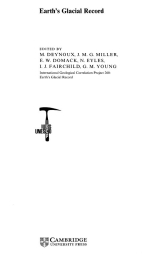Добрый день, Коллеги. Важное сообщение, просьба принять участие. Музей Ферсмана ищет помощь для реставрационных работ в помещении. Подробности по ссылке
Earth's Glacial Record / Ледниковые записи Земли
This volume represents the final contribution of the International Geological Correlation Program Project 260 'Earth's Glacial Record'. The project was active from 1987 until 1991. It succeeded IGCP Project 24 'Quaternary Glaciations in the Northern Hemisphere', and Project 38 'Pre-Pleistocene Tillites'. Thus, its goal was to promote further research on glaciations, whatever their age and location, and to encourage geologists working in Modern or Quaternary sequences and those working on Pre-Pleistocene rocks to share their experience and different approaches. In this way we hoped to emphasize and illuminate global aspects of glacial phenomena in addition to facies description and regional problems. Participants in the project were encouraged to consider the tectonic versus climatic control on sedimentation in glacially influenced basins, the nature of the feedback between plate positioning, tectonics, and climate, and the paleoenvironmental significance and distribution of specific rock types (e.g. black shales, carbonates, iron formations, etc.) during and immediately after glacial periods. These ambitious objectives were addressed by three subgroups that were in charge of, respectively, geodynamic setting, paleomagnetic reconstructions, and significance of specific rock types. Yearly meetings and field trips were held in various countries (10 field trips in Canada, Brazil, USA, UK, Mali), covering a vast variety of structural terranes (active and passive margins, intracratonic basins) from Proterozoic up to Modern in age. This clearly demonstrated the interest in and necessity for such a comprehensive approach among geologists. We do not pretend that all objectives were perfectly met, but aspects have been clarified and progressively more communications on global climatic or tectonic implications were presented during the successive meetings. This awareness of the importance of a global approach is certainly one of the most significant results of the project <...>




